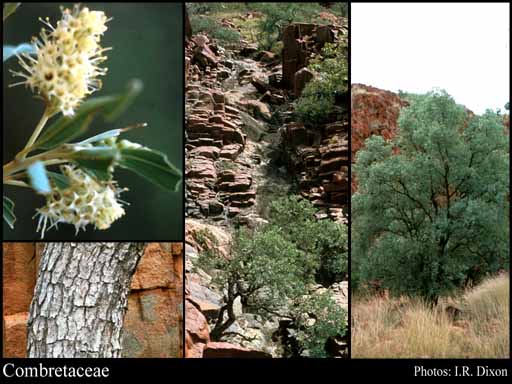- Reference
- Prodr.Fl.Nov.Holland. 351 (1810)
- Name Status
- Current

Scientific Description
Common name. Indian Almond Family.
Habit and leaf form. Trees, or shrubs, or lianas. Self supporting, or climbing (commonly); when climbing, stem twiners, or scrambling (via hooks representing persistent petiole bases). Combretum twining anticlockwise. Mesophytic to xerophytic (often in savanna), or helophytic. Leaves alternate, or opposite, or whorled (rarely); spiral, or distichous, or four-ranked; non-sheathing; gland-dotted, or not gland-dotted; simple. Leaf blades entire; pinnately veined; cross-venulate. Leaves minutely with stipules, or without stipules. Leaf blade margins entire. Leaves without a persistent basal meristem. Domatia recorded (from 11 genera and numerous species); represented by pits, or pockets, or hair tufts (mostly). Leaf anatomy. Hydathodes present (occasionally), or absent. Stem anatomy. Nodes unilacunar. Secondary thickening developing from a conventional cambial ring, or anomalous; from a single cambial ring. Roots. Aerial roots present, or absent.
Reproductive type, pollination. Fertile flowers hermaphrodite, or hermaphrodite and functionally male. Unisexual flowers present, or absent. Plants hermaphrodite, or andromonoecious. Plants viviparous (in the mangroves), or not viviparous.
Inflorescence and flower features. Flowers aggregated in ‘inflorescences’; in racemes, in spikes, and in heads. The terminal inflorescence unit usually racemose. Inflorescences usually racemose. Flowers usually small; regular; 3–8 merous; cyclic; tetracyclic, or pentacyclic. Free hypanthium present. Perianth with distinct calyx and corolla, or sepaline (the corolla sometimes absent); 4–5, or 9–10(–16); 1 -whorled, or 2 -whorled; isomerous. Calyx 4–5(–8); 1 -whorled; gamosepalous (as lobes from the hypanthium); imbricate, or valvate (or very small); regular; persistent. Corolla when present, 4–5(–8); 1 -whorled; polypetalous; when present, imbricate, or valvate; regular. Androecium often 10 (commonly twice K), or 5 (sometimes outer whorl missing), or 10–100 (rarely ‘many’). Androecial members free of the perianth; all equal; free of one another (usually), or coherent (rarely grouped); 2 -whorled (usually), or 1 -whorled (sometimes the outer missing), or 3 -whorled (rarely). Androecium exclusively of fertile stamens. Stamens 5, or 10, or 11–30; isomerous with the perianth, or diplostemonous (commonly), or polystemonous; oppositisepalous. Anthers dorsifixed; versatile; dehiscing via longitudinal slits; tetrasporangiate. Fertile gynoecium present, or absent (male flowers). Gynoecium 2–5 carpelled. The pistil 1 celled. Gynoecium syncarpous; synstylovarious, or eu-syncarpous; inferior. Ovary unilocular; 1 locular. Epigynous disk present. Gynoecium stylate, or non-stylate (e.g. some male flowers in Terminalia). Styles 1. Stigmas wet type; non-papillate; Group IV type. Placentation apical. Ovules in the single cavity 2–5(–6); pendulous; non-arillate; anatropous.
Fruit and seed features. Fruit fleshy, or non-fleshy; indehiscent (usually), or a schizocarp; usually a drupe. Dispersal often by water, by animals or by wind (the wind-dispersed forms winged). Seeds non-endospermic. Embryo well differentiated (the cotyledons usually convolute, sometimes folded, sometimes massive and hemispherical). Cotyledons 1 (by concrescence), or 2, or 3 (folded or twisted, rarely hemispherical). Embryo chlorophyllous (2/2), or achlorophyllous (1/1). Seedling. Germination phanerocotylar, or cryptocotylar.
Physiology, biochemistry. Aluminium accumulation not found.
Special features. Mangroves, or non-mangrove species.
Geography, cytology, number of species. World distribution: widespread. X = 7, 11–13. 600 species.
Keys
Western Australian Genera and Families of Flowering Plants — an interactive key
T.D. Macfarlane, L. Watson, N.G. Marchant